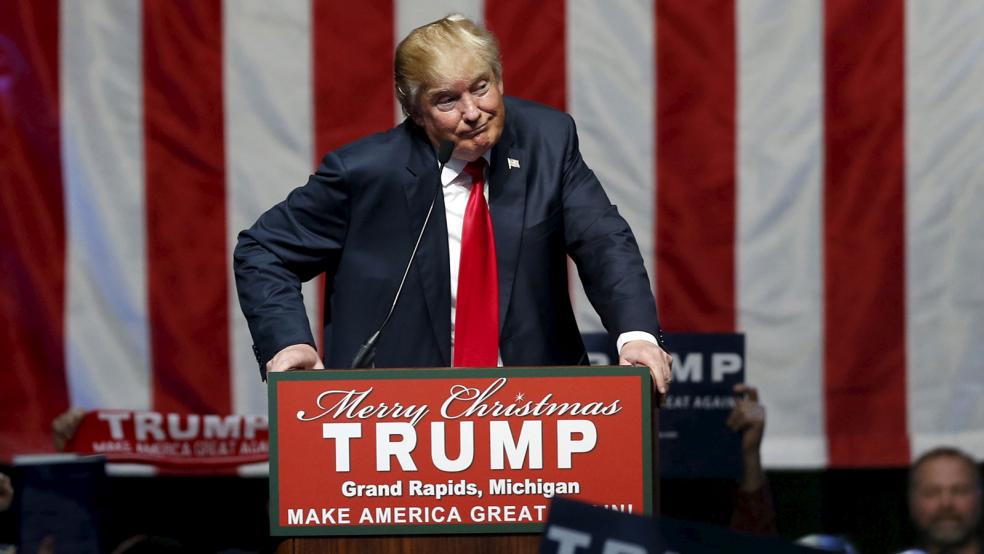A great Christmas present for American voters would be some clarity in national polling results, but a look at two of the most recent national surveys on the Republican presidential primary suggests Santa won’t be delivering the goods.
On Wednesday, CNN released a national poll showing that Donald Trump continues to lead the GOP pack with a commanding 21-percentage point lead over his nearest rival, Texas Sen. Ted Cruz. With 39 percent of the vote to Cruz’s 18, Trump expanded his margin by one point compared to the same poll taken last month, even as both candidates saw their share of support increase.
Related: Would You Be Embarrassed to Have Trump As President?
Taken on its own, the CNN poll appears to paint a compelling picture of a race that is Trump’s to lose. But it came out just one day after another national poll, this one from Quinnipiac University, showed a far tighter race. According to Quinnipiac, Trump still leads the GOP field, but carries only 28 percent of the vote, while Cruz comes in at 24 percent – within the poll’s margin of error, which means it is a statistical dead heat.
The polls both sampled a national pool of registered Republicans and Independents who say that they lean Republican and combined their results to get their numbers for “GOP voters.” Quinnipiac was in the field from December 16 to December 20. CNN began its poll on the 17th and concluded it on the 21st .
The wording of the question was similar, as well.
Quinnipiac asked, “If the Republican primary for President were being held today, and the candidates were Jeb Bush, Ben Carson, Chris Christie, Ted Cruz, Carly Fiorina, Jim Gilmore, Lindsey Graham, Mike Huckabee, John Kasich, George Pataki, Rand Paul, Marco Rubio, Rick Santorum, and Donald Trump, for whom would you vote?”
Related: What a Putz – Trump Drops to a New Low
CNN asked: “I'm going to read a list of people who are running in the Republican primaries for president in 2016. After I read all the names, please tell me which of those candidates you would be most likely to support for the Republican nomination for president in 2016, or if you would support someone else.”
In both cases, the names of the candidates were read in random order.
Unless you have a vested interest in one of the polls being more reliable than the other – for instance, if you happen to be Donald Trump – it’s hard to see a substantial difference between the two.
.@FoxNews treats me so badly. Using old Quinnipiac Poll where I have a much smaller lead than the just out @CNN Poll. All negative!
— Donald J. Trump (@realDonaldTrump) December 23, 2015
How is it that the results they generated for the leading candidates were so different? A possible explanation could be behind-the-scenes weighting that the pollsters apply to their samples in order to capture the diversity of the electorate. Another is that one of the polls is a statistical anomaly – standard practice in political polling is to present margins of error with 95 percent certainty, meaning there’s a 5 percent chance that the real number in the electorate as a whole is outside each poll’s margin of error.
Related: Trump’s Tax Cuts Would Add $24.5 Trillion to the Debt
However, the likeliest explanation might be the one found in Quinnipiac’s results, when voters were asked how fixed they are in their opinions. Nearly 60 percent of voters who picked a preferred candidate said that they remain open to changing their mind.
Between Trump and Cruz, however, the level of voter certainty was dramatically different. Among voters who said they would support Trump, 63 percent said that they would not change their minds, while 36 percent remained open to persuasion. Cruz voters were almost exactly the opposite, with only 36 percent saying they won’t change their minds, and 64 percent saying they are persuadable.
As the presidential primary races shifts into low-power mode over the holiday, the biggest lesson from the last two major national polls might just be that most voters simply haven’t engaged with the campaign at a level that makes polling a really reliable source of data yet.





